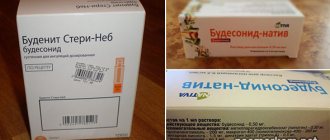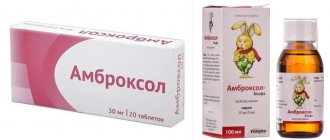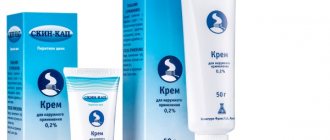A rather unpleasant and even dangerous disease is bronchial asthma, which requires the strictest control from the person suffering from it. Asthma is classified as an infectious-allergic disease and is characterized by bronchospasm. Bronchospasm is a sudden contraction of the muscles of the bronchial wall, which is accompanied by a narrowing of the bronchi, which, in turn, leads to a deterioration in ventilation of the lungs. As a result, an attack of suffocation and panic occurs.
The inhalation drug “Ventolin”, instructions and reviews of which are described below, can alleviate the patient’s condition and also prevent an attack of bronchospasm.
Description of the drug
"Ventolin" is an anti-asthmatic drug used in the treatment and prevention of various diseases of the lungs and bronchi, which lead to spasms of the smooth muscles of the bronchi. "Ventolin" for inhalation is a clear liquid, sometimes light yellow in color.
The active ingredient of the drug is salbutamol, which suppresses bronchial reactivity and helps prevent or eliminate the phenomenon of bronchospasm. The instructions describe the auxiliary components included in the drug “Ventolin” (for inhalation) as substances that facilitate the most convenient administration and uniform distribution of salbutamol in the patient’s body.
Salbutamol, when administered into the respiratory tract, affects the smooth muscles of the bronchi, while ensuring their complete relaxation, reducing airway resistance, and also increasing the volume of inhaled air. In addition, the active ingredient of the drug "Ventolin" stimulates the secretion of the bronchial glands, and also activates the work of the ciliated epithelium of the bronchi, due to which mucus is removed during coughing. In therapeutic doses, salbutamol, the active component of the drug Ventolin (for inhalation), can cause a decrease in blood pressure and an increase in heart rate.
The breakdown products of salbutamol are excreted from the body in urine and partially in feces.
Analogues of the drug according to ATC codes:
VENTOLIN VENTOLIN VENTOLIN NEBULES SALAMOL ECO SALAMOL ECO EASY BREATHING SALGIM SALGIM All
Before using VENTOLIN you should consult your doctor. These instructions for use are for informational purposes only. For more complete information, please refer to the manufacturer's instructions.
Contraindications
As for contraindications to the use of the drug "Ventolin" (for inhalation), these include hypersensitivity to one or more components of the drug. Pregnant women who are at risk of premature birth or miscarriage, as well as children under 2 years of age, should not take the medicine.
In addition, you should take the drug with extreme caution:
- with myocarditis;
- with coronary heart disease;
- for heart defects;
- with aortic stenosis;
- with tachyarrhythmia;
- for glaucoma;
- with aortic stenosis;
- with thyrotoxicosis;
- with diabetes mellitus in the stage of decompensation;
- for epilepsy;
- with liver and kidney failure;
- with arterial hypertension;
- during pregnancy and lactation.
The instructions for the drug "Ventolin" (for inhalation) allow in rare cases the use of the drug by pregnant and nursing mothers. In this case, the expected effect on a woman’s health should significantly exceed the risk of developing pathologies in a child or fetus. This warning is due to the fact that in the course of a number of studies, cases of negative effects on the fetus were observed, as a result of which pathologies in the form of a “cleft palate” and congenital deformities of the limbs were identified. Although, on the other hand, a cause-and-effect relationship between taking the medication and fetal pathologies could not be established, since the test mothers also took other medications. There is also no data on the effect of salbutamol, which is the active ingredient of the drug Ventolin for inhalation, on a newborn child. Reviews from doctors therefore exclude the use of the drug by lactating and pregnant women.
Pharmacological authorities
Pharmacodynamics.
Salbutamol is a selective beta2-adrenergic receptor agonist. At therapeutic doses it affects beta2-adrenergic receptors of the bronchial muscles.
Pharmacokinetics.
After inhalation stagnation, 10 to 20% of the administered dose reaches the lower respiratory tract. Reshta is lost from the delivery system or from the oropharynx, the signs are confused. Part of the dose that reaches the respiratory system is absorbed from the tissue of the legs and is absorbed into the bloodstream, but is not metabolized in the legs.
The bronchodilatory effect of the drug lasts for 5 weeks after inhalation, the duration of treatment lasts for 4–6 years.
After being consumed in the systemic bloodstream, the drug is metabolized in the liver, and appears to be the main source of the drug, which remains unchanged and appears as a phenolsulfate metabolite.
The dose of the drug, which has been absorbed from the nasopharynx to the herbal system, is absorbed through the scolio-intestinal tract, undergoes the first stage of metabolism in the liver until it reaches the phenol sulfate stage, then appears as liquid.
Side effects
Side effects from taking Ventolin can be divided into common, infrequent, rare and very rare. Common side effects include headache, dizziness, tachycardia and skeletal muscle tremors. Infrequently, muscle spasms, palpitations, and irritation of the pharynx and oral mucosa occur. In rare cases, hypokalemia and dilation of peripheral blood vessels occur. Very rarely, as reviews from doctors and patients show about the drug “Ventolin” (for inhalation), arrhythmia, hyperactivity, extrasystole, lactic acidosis, superventricular tachycardia, as well as some allergic reactions such as collapse or decreased blood pressure, urticaria, edema or bronchospasm may be observed. .
Side effects
Adverse reactions, listed below, are classified according to organs and systems and therefore according to the frequency of occurrence. The frequency of guilt is classified as very often (³1/10), often (³1/100 and <1/10), infrequently (³1/1000 and <1/100), rarely (³1/10,000 and <1/1000), even rarely (< 1/10,000), including single episodes. Unfortunately, even very often, side effects are detected based on clinical observations, while rarely, even rarely, and with an unknown frequency, based on spontaneous reports.
On the side of the immune system
Very rarely: hypersensitivity reactions, including angioedema, urticaria, bronchospasm, hypotension and collapse.
On the side, the exchange of speech, metabolism
Rarely: hypokalemia. Potentially severe hypokalemia may result from beta2-agonist treatment.
Frequency unknown: lactic acidosis (div. section “Peculiarities of stasis”).
Neurological disorders
Common: tremor, headache.
Very rarely: hyperactivity.
Cardial damage
Often: tachycardia.
Uncommon: stronger heartbeat.
Very rarely: disruption of heart rhythm, including atrial fibrillation, supraventricular tachycardia and extrasystole.
Unknown frequency: myocardial ischemia (div. section “Peculiarities of congestion”).
The fragments reported are spontaneous, and their frequency is not determined based on post-registration precautions.
On the side of the ship
Rarely: peripheral vasodilation.
On the side of the thoracic system, the organs of the thoracic clitoris and the mediastinum
Very rarely: paradoxical bronchospasm.
On the side of the scilicointestinal tract
Uncommon: teasing of the mucous membranes of the empty mouth and pharynx.
On the side of the musculoskeletal apparatus and the successful system
Infrequently: m'yazovі courts.
Instructions for use of the drug
1. “Ventolin”: nebulas for inhalation.
The instructions for the drug describe the use of nebulas using a special device - a nebulizer. The solution for inhalation must be prepared by adding sterile saline solution (total volume is 2-2.5 ml). Through a nebulizer, the patient inhales the resulting solution until the aerosol formation completely stops. On average, one inhalation procedure takes about 10 minutes.
Sometimes, in order to speed up the effect, it is allowed to use an undiluted solution of the drug “Ventolin” (for inhalation), the dosage of which is prescribed by the doctor. In this case, the inhalation procedure lasts no more than 5 minutes.
It is very important to carry out the procedure in a well-ventilated area and under the direct supervision of a doctor.
2. Aerosol.
Using an aerosol of the drug “Ventolin” for the first time or if the product has not been used for some time, you should remove the safety cap from the cylinder, while squeezing its edges on the sides. Before use, shake the can well and press the valve to make sure that the aerosol mechanism is working properly.
Having installed the mouthpiece, shake the inhaler again and position the balloon so that its bottom is directed upward, hold the inhaler in the bottom area with your index finger, and place your thumb on the base and under the mouthpiece.
Before using the drug directly, the patient should exhale slowly and deeply and clasp the end of the mouthpiece with his lips. Next, you need to press the bottom of the inhaler with your index finger and at the same time inhale deeply through your mouth. After taking one dose of the medicine, you need to hold your breath for a few seconds and then exhale slowly. The next dose of the drug is taken after half a minute. The mouthpiece is then closed with a cap.
When administering the drug "Ventolin" (for inhalation), the patient should under no circumstances rush. Using the aerosol for the first time, you can practice standing in front of a mirror. If traces of escaping aerosol are noticeable in the upper part of the inhaler or in the area of the corners of the mouth during administration, the drug administration procedure should be started over.
The mouthpiece must be cleaned once a week, and:
- before rinsing the mouthpiece with warm running water, you need to remove the bottle from the plastic case and remove the lid;
- Wash the mouthpiece and body under running water without overheating them;
- after all the parts have dried, you should insert the cylinder back into the body and close it with the mouthpiece cover;
- The cylinder must not be immersed in water.
Features of good stagnation
Ventolin Nebula should only be used by inhalation through the mouth and should not be administered by injection or injection.
Treatment of bronchial asthma should be carried out using a step-by-step program; the patient's condition should be assessed clinically and with the help of functional lung tests.
The increased frequency of use of short-acting inhaled beta2-agonists indicates improved control of bronchial asthma. In such cases, it is necessary to change the treatment of the patient.
Raptova and progressive deterioration of bronchial asthma are unsafe for life, which will require an increase in the depletion of corticosteroids. Patients who are diagnosed with a risk group are advised to closely monitor the maximum fluidity of their vision.
For patients who are treated with the drug Ventolin Nebula at home, it is necessary to be informed about the following: if the initial effective dose of the drug does not bring relief, but the severity of this relief changes, then contact the doctor, and do not increase the dose of the drug or frequency he has stagnation independently.
Ventolin Nebula should be used with care for the treatment of patients when large doses of other sympathomimetics are taken.
The accumulation of sympathomimetics, including salbutamol, affects the cardiovascular system. Post-licensing and published literature data provide evidence of rare episodes of myocardial ischemia associated with salbutamol administration. Patients with severe cardiovascular diseases (for example, ischemic heart disease, arrhythmia or severe heart failure) should take off salbutamol in case of chest pain or other symptoms that Be aware of acute illnesses of the heart, and then seek medical help. We would like to focus on the assessment of such symptoms as back pain and chest pain, which can be either heart disease or illness of the respiratory system.
With caution, salbutamol is used in cases of thyrotoxicosis.
When patients were treated with a combination of salbutamol in nebulae and ipratropium bromide inode, the development of acute closed-cuta glaucoma was prevented. Therefore, the combination of salbutamol in patients with anticholinergic drugs, which are also administered by nebulization, should be mixed with caution. Patients must follow the instructions to properly infuse the drug and be careful not to get the sprayed aerosol in the eyes.
Treatment with beta2-agonists may result in severe hypokalemia; The main thing to be careful with is the administration of parenteral forms or a nebulizer. Particularly important in patients with severe bronchial asthma is that hypokalemia can be potentiated by concomitant effects of xanthine derivatives, steroids, diuretics and hypoxia. In this situation, it is recommended to check the blood serum potassium levels.
As with other inhalation medications, paradoxical bronchospasm may occur due to increased wheezing. It is important to consider alternative forms of the drug or other liquid inhaled bronchodilators. Ventolin Nebula should be carefully removed and, when necessary, use other liquid bronchodilators on a permanent basis.
Like other beta-adrenergic receptor agonists, Ventolin Nebula can cause metabolic changes, for example, an increase in the level of sugar in the blood.
Compensation for such changes in patients with diabetes is not always possible, in addition to knowledge about the development of ketoacidosis in such patients. The sudden depletion of corticosteroids can inflame the whole region.
Very rarely, in patients with bronchial asthma in the advanced stage, who were treated with high doses of salbutamol, which was taken internally or through a nebulizer, episodes of lactic acidosis were reported (section “Adverse reactions” ii"). Increased levels of lactate in the blood can cause development of the backbone and compensatory hyperventilation of the lungs, which can be considered as a lack of effectiveness of anti-asthmatic treatment and, in turn, lead to incomplete delivery Intensification of treatment with short-acting beta2-agonists. It is therefore recommended to monitor rhubarb lactate levels in the blood serum of such patients and, presumably, the presence of metabolic acidosis in them.
Dosage of the drug
1. Solution for inhalation.
The instructions for the drug “Ventolin” (nebulas for inhalation) allow you to take it in diluted or undiluted form. The method of administration and dosage are determined by the attending physician depending on the age and health of the patient.
For children over 12 years of age and adults the drug is prescribed:
- Divorced. Mix 0.5-1.0 ml of Ventolin with saline solution. The total volume should be 2.0-2.5 ml. Next, the resulting solution must be placed in a nebulizer and inhaled until the formation of aerosol stops.
- In its purest form. Place 2.0 ml of the drug in a nebulizer and inhale. On average, the procedure takes no more than 5 minutes.
Children from 2 to 12 years old are prescribed the drug in diluted form. 0.5 ml of the drug “Ventolin” (solution for inhalation) is diluted with physiological solution so that the total volume is 2.0-2.5 ml. The inhalation procedure is carried out using a nebulizer. Sometimes, as prescribed by a doctor, in severe cases the dose of the drug can be increased to 1.0 ml.
The number of procedures is prescribed by the doctor. Repeated inhalation is carried out after 20 minutes, but no more than 4 times a day.
2. Aerosol.
Children over 12 years old and adults:
- 100-200 mcg (1-2 injections) – for acute attacks of bronchospasm.
- 200 mcg (2 injections) – prevention of acute attacks of bronchospasm when exposed to an allergen or physical stress.
- 200 mcg (2 injections) – as maintenance therapy, which is prescribed for a long time.
Children from 2 to 12 years old:
- 100 mcg (1 injection) – for acute attacks of bronchospasm.
- 100 mcg (1 injection) – for the prevention of bronchospasm attacks, 15 minutes before exposure to the provoking factor.
- 100 mcg (1 injection) – as maintenance therapy for a long time. Take no more than 4 times a day.
Ventolin
Name:
Ventolin
Release form, composition and pack
Aerosol dosed for inhalation in the form of a white or almost white suspension. 1 dose of salbutamol sulfate is 120.5 mcg, which corresponds to the content of salbutamol 100 mcg. Excipients: propellant 1,1,1,2-tetrafluoroethane (HFA 134a) does not contain chlorofluorocarbons. .
Clinical and pharmacological group: Bronchodilator product - beta2-adrenergic agonist.
pharmachologic effect
Selective beta2-adrenergic agonist. In therapeutic doses, it acts on β2-adrenergic receptors of bronchial smooth muscle, having a minor effect on β1-adrenergic receptors of the myocardium. Salbutamol inhibits the release of histamine, leukotrienes, prostaglandin D2 and other biologically active substances from mast cells for a long time. Suppresses early and late bronchial reactivity. It has a pronounced bronchodilator effect, preventing or relieving bronchospasm, and reduces resistance in the respiratory tract. Increases vital capacity of the lungs.
Increases mucociliary clearance (in chronic bronchitis up to 36%), stimulates mucus secretion, activates the functions of the ciliated epithelium. Inhibits the release of inflammatory mediators from mast cells and basophils, in particular the release of histamine induced by antibodies to immunoglobulin E, eliminates antigen-dependent suppression of mucociliary transport and the release of neutrophil chemotaxis factor.
Prevents the development of allergen-induced bronchospasm. May lead to a decrease in the number of β1-adrenergic receptors, incl. on lymphocytes. It has a number of metabolic effects: it reduces the concentration of potassium in plasma, affects glycogenolysis and insulin secretion, has a hyperglycemic (especially in patients with bronchial asthma) and lipolytic effect, and increases the risk of developing acidosis.
Pharmacokinetics
Absorption and Metabolism
After inhalation administration, 10-20% of the dose of salbutamol reaches the lower respiratory tract. The rest of the dose remains in the inhaler or is deposited in the oropharynx and is then swallowed.
The fraction deposited in the respiratory tract is absorbed into the lung tissue and blood, but is not metabolized in the lungs. The ingested portion of the inhalation dose is absorbed from the gastrointestinal tract and undergoes extensive first-pass metabolism through the liver, turning into inactive 4′-O-sulfate (phenolic sulfate).
Distribution
The binding of salbutamol to plasma proteins is 10%.
Removal
With intravenous administration, T1/2 of salbutamol is 4-6 hours. Unchanged salbutamol and the conjugate are excreted mainly in the urine. Only a small part of the administered dose of salbutamol is excreted in the feces. Most of the dose of salbutamol administered intravenously, orally, or by inhalation is eliminated within 72 hours.
Indications
Bronchial asthma:
- relief of attacks of bronchial asthma, incl. with exacerbation of severe bronchial asthma;
- prevention of bronchospasm attacks associated with exposure to an allergen or caused by physical activity;
- use as one of the components in long-term maintenance therapy of bronchial asthma.
Chronic obstructive pulmonary disease (COPD), accompanied by reversible airway obstruction, including chronic bronchitis and emphysema.
Dosage regimen
Ventolin metered dose aerosol is intended for inhalation administration only. Only a doctor can decide whether to increase the dose or frequency of use of the product. It is not recommended to use Ventolin more than 4 times a day. The need for frequent use of Ventolin in maximum doses or a sudden increase in dose indicates a worsening of the disease. Adults (including elderly patients). Relieving an attack of bronchospasm: the recommended dose is 100-200 mcg (1-2 inhalations).
Prevention of bronchospasm attacks associated with exposure to an allergen or caused by physical activity: the recommended dose is 200 mcg (2 inhalations) 10-15 minutes before exposure to the provoking factor. Long-term maintenance therapy: the recommended dose is up to 200 mcg (2 inhalations) 4 times a day. Ventolin can be administered through the Volumatic spacer.
Children Relieving an attack of bronchospasm: the recommended dose is 100-200 mcg (1-2 inhalations). Prevention of bronchospasm attacks associated with exposure to an allergen or caused by physical activity: the recommended dose is 100-200 mcg (1-2 inhalations) 10-15 minutes before exposure to the provoking factor. Long-term maintenance therapy: the recommended dose is up to 200 mcg (2 inhalations) 4 times a day. Ventolin can be administered through the Babyhaler or Volumatic spacer.
Side effect
Allergic reactions: very rarely - angioedema, urticaria.
- From the side of the central nervous system: often - tremor, headache; very rarely - hyperactivity.
- From the cardiovascular system: often - tachycardia; very rarely - arrhythmia, supraventricular tachycardia, extrasystole, dilatation of peripheral vessels.
- From the respiratory system: very rarely - bronchospasm.
- From the digestive system: not often - irritation of the mucous membrane of the oral cavity and pharynx.
- From the musculoskeletal system: uncommon - muscle cramps.
- Metabolic disorders: uncommon - hypokalemia.
Contraindications
- management of preterm birth;
- threatened abortion;
- children under 2 years of age;
- high susceptibility to any component of the product.
Pregnancy and lactation
During pregnancy and lactation, the product is prescribed only in cases where the expected benefit to the mother exceeds any possible risk to the fetus. Salbutamol probably passes into breast milk.
There is no data on whether salbutamol present in breast milk is harmful to the newborn. Special instructions The patient should be instructed on the correct use of the Ventolin inhaler. Bronchodilators should not be the only or main component of the treatment of unstable or severe bronchial asthma.
If the effect of the usual dose of Ventolin becomes less effective or shorter lasting (the effect of the product lasts for at least 3 hours), the patient should consult a doctor. An increased need for the use of inhaled β2-adrenergic agonists with a short duration of action to control the symptoms of bronchial asthma indicates an exacerbation of the disease. In such cases, the treatment plan should be reconsidered.
A sudden and progressive deterioration in the course of bronchial asthma can pose a threat to the patient’s life, therefore, in such situations, it is necessary to urgently decide on the issue of prescribing or increasing the dose of GCS. In such patients, daily monitoring of peak expiratory flow is recommended. Use the product with caution in patients with thyrotoxicosis. Therapy with β2-adrenergic agonists, especially when administered parenterally or by nebulizer, can lead to hypokalemia.
Particular caution is recommended when treating severe attacks of bronchial asthma, since in these cases hypokalemia may increase as a result of the simultaneous use of xanthine derivatives, corticosteroids, diuretics, also due to hypoxia. In such situations, it is necessary to monitor the level of potassium in the blood serum.
Impact on the ability to drive vehicles and operate machinery
There are no data on the effect on the ability to drive vehicles and/or other mechanisms.
Overdose
Symptoms: hypokalemia is possible.
Treatment: if overdose is suspected, serum potassium levels should be monitored. Antidotes are cardioselective beta-blockers. However, beta-adrenergic blockers should be used with caution in patients with a history of bronchospasm attacks.
Drug interactions
The simultaneous use of salbutamol and non-selective beta-adrenergic blockers such as propranolol is not recommended. Salbutamol is not contraindicated in patients receiving MAO inhibitors.
Storage conditions and periods
The drug should be stored at temperatures below 30°C.
Shelf life – 2 years. The inhaler should not be frozen or exposed to direct sunlight. Attention! Before using Ventolin, you should consult your doctor. The instructions are provided solely for familiarization with “ Ventolin ”.
The drug "Ventolin": inhalation for children
The drug can be prescribed for the prevention and treatment of bronchospasm in children over 2 years of age. In rare cases, the drug is prescribed to children from 18 months. Even less often, the drug is used at an earlier age, since there is no data on the effect of Ventolin on the body of children under 18 months.
As reviews show about the drug “Ventolin” (nebulas for inhalation), it is most often prescribed for a short period of time, taking into account the severity of the disease, the age of the child, concomitant diseases, as well as the use of other medications.
If it is not possible to use an aerosol or to increase the effectiveness of the drug, the administration of salbutamol may be recommended using a nebulizer. The dosage, nature and frequency of administration of salbutamol are prescribed by the attending physician for each child individually.
Interaction with other drugs
Ventolin and non-selective beta blockers should not be taken at the same time. "Ventolin" can increase tachycardia in thyrotoxicosis. It can also enhance the effects of drugs that stimulate the central nervous system. While taking cardiac glycosides, the drug increases the likelihood of developing arrhythmia. The likelihood of tachyarrhythmias increases when taking Ventolin and Theophylline simultaneously. After taking Ventolin and anticholinergics together, intraocular pressure may increase. During pregnancy, the drug should be used with great caution, as hyperglycemia and tachycardia may occur in the fetus and mother. Taking it can also cause a decrease in blood pressure, weakness in labor, and even pulmonary edema.
Reviews about the medicine
It is very important to understand that in order to obtain a positive effect, you should carefully study the instructions for the drug “Ventolin” (for inhalation), how to dilute the product and in what quantity.
In general, reviews of the drug are positive; many patients note its good tolerability and sufficient effectiveness in the treatment of bronchospasms. Some side effects such as headache and dizziness, tachycardia or skeletal muscle tremors occur very rarely. To reduce them to a minimum, you should pay special attention to the question of how to inhale with Ventolin.
special instructions
If the effect of Ventolin begins to have less effect over time and the duration of action of the drug decreases, this may indicate a deterioration in the patient’s condition.
Pregnant women are prescribed the drug only in cases of extreme necessity, when the benefits to the mother significantly outweigh the potential risks to the pregnant child. Ventolin should not be used during lactation, as there is evidence that the drug passes into breast milk.
In the case of treatment with Ventolin in nebulas, the solution remaining in the inhalers is not reused, but poured out.









